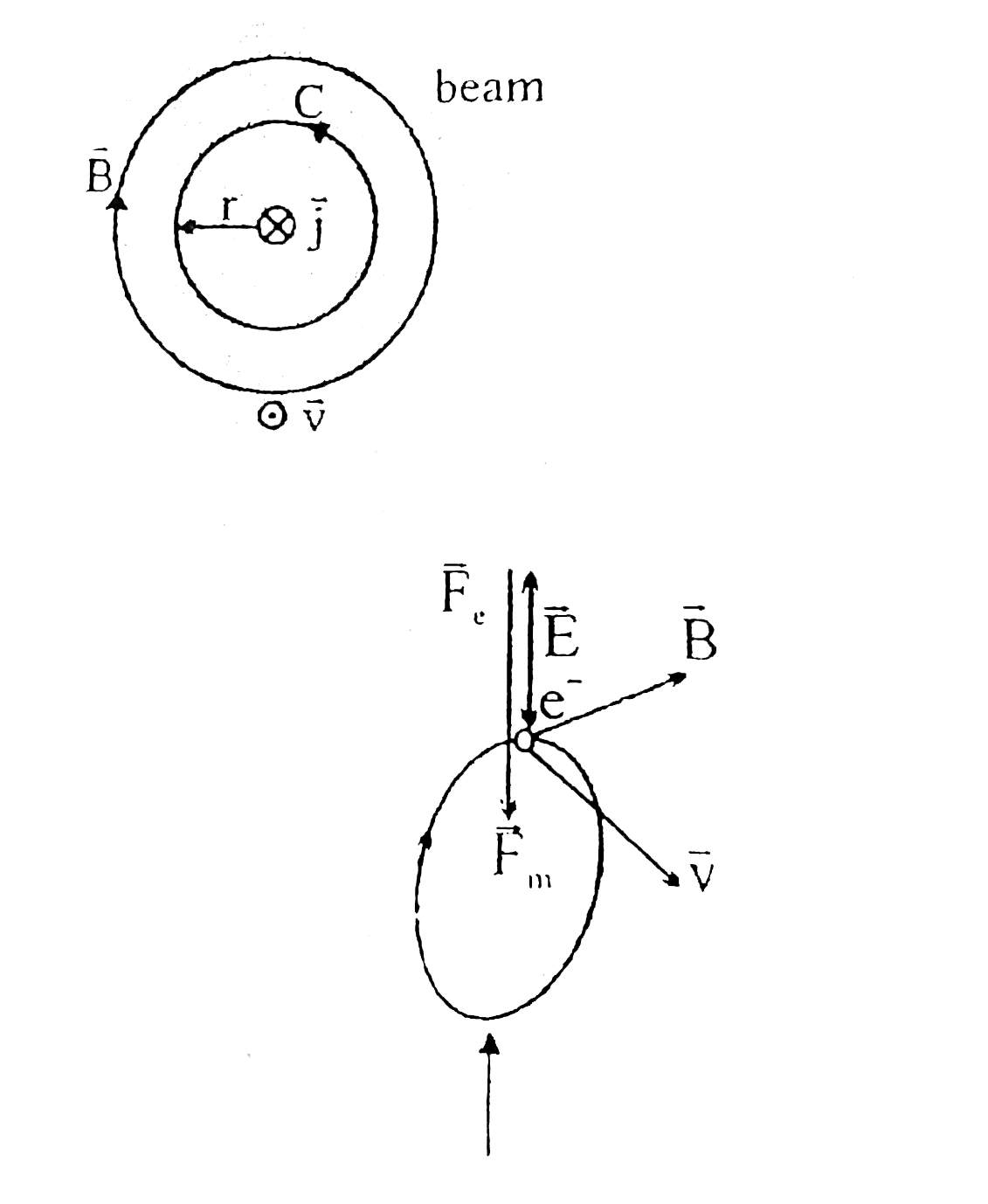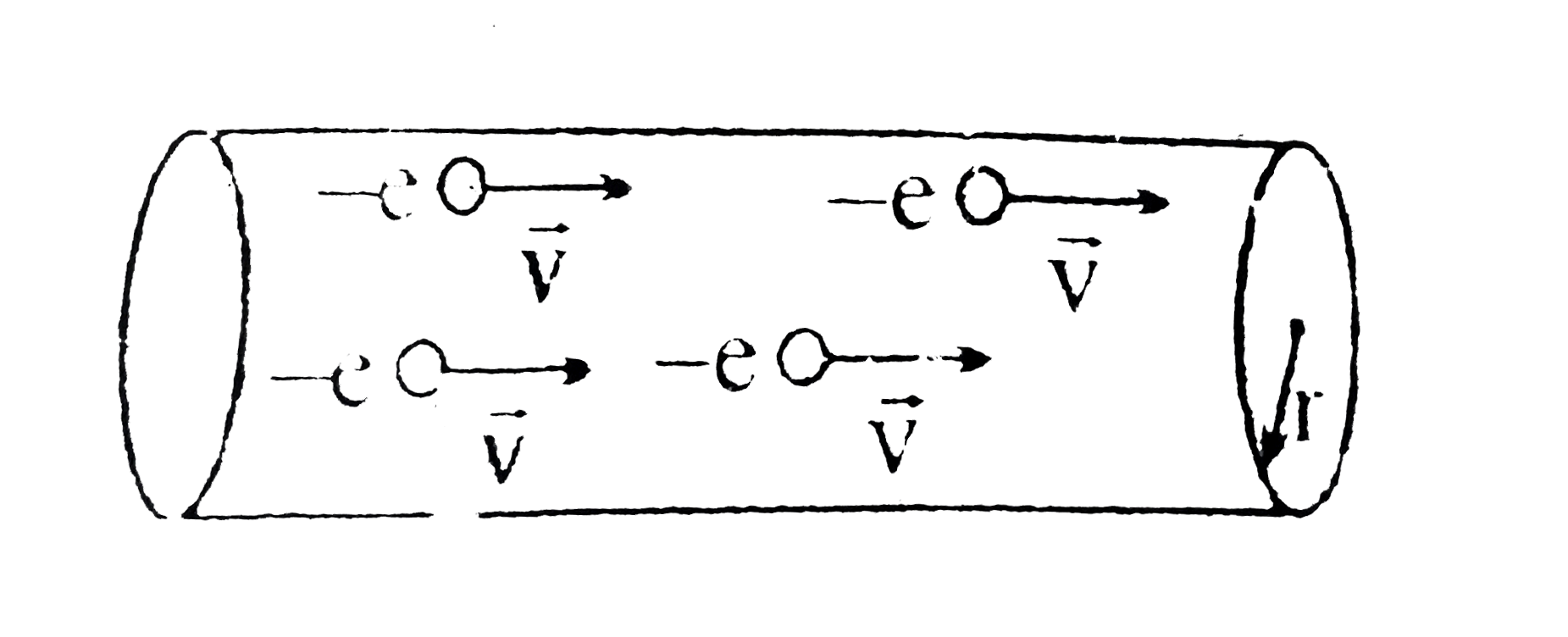A beam of electrons has radius r and contains 'n' electrons per cubic meter moving with velocity →v along the beam (figure). Assume that a beam that is much longer than its diameter forms a cylinderically symmetric distribution of charge and current. The beam expands if the electric force exceeds the magnetic force. So long as the expansion is slow, the approximations of cylindrical symmetry and static fields remain valid.
 What is electric field produced on the edge of the beam?
What is electric field produced on the edge of the beam?
→E=ner4ɛ0ˆr
→E=ner2ɛ0ˆr
→E=−ner4ɛ0ˆr
→E=−ner2ɛ0ˆr
The correct Answer is:D
The total charge inside the cylinder is Q=−neπr2l
Applying Gauss's law givesϕE=Q/∈0
2πrlEr=−neπr2l∈0⇒→E=−ner2∈0ˆr
The circulation of →B around the circle is ɛ=2πrB0
The position direction for current is along the axis parallel to →v
The current passing through the circle is
I=−πr2j=−πr2≠v
Applying Ampere's law we obtain ɛ=μ0I
2πrB0=−μ0πr2≠v⇒→B=12μ0≠vr(−ˆθ)
The total force acting on an electron is the sum of the electric and magnetic forces
→F=−e(→E+→v×→B)=e(ner2∈0−μ0nerv22)ˆr=ne2r2∈0(1−μ0∈0v2)ˆr]

Topper's Solved these Questions
- BOOK - BANSALCHAPTER - MASTER PRACTICE PROBLEMEXERCISE - Reasoning75videos
MASTER PRACTICE PROBLEM
- BOOK - BANSALCHAPTER - MASTER PRACTICE PROBLEMEXERCISE - Multiple objective131videos
MASTER PRACTICE PROBLEM
- BOOK - BANSALCHAPTER - MASTER PRACTICE PROBLEMEXERCISE - Additional topic70videos
MASTER PRACTICE PROBLEM
- BOOK - BANSALCHAPTER - FLUID MECHANICSEXERCISE - PYQS AIEEE10videos
FLUID MECHANICS
- BOOK - BANSALCHAPTER - SEMICONDUCTORSEXERCISE - CBSE Question32videos
SEMICONDUCTORS
Similar Questions
An electron beam projected along + X-axis, experience a force due to a magnetic field along the + Y-axis. What is the direction of the magnetic field?
View SolutionAn electron beam projected along + X-axis, experience a force due to a magnetic field along the + Y-axis. What is the direction of the magnetic field?
View Solution
Knowledge Check
- Question 1 - Select One
A beam of electrons has radius r and contains 'n' electrons per cubic meter moving with velocity →v along the beam (figure). Assume that a beam that is much longer than its diameter forms a cylinderically symmetric distribution of charge and current. The beam expands if the electric force exceeds the magnetic force. So long as the expansion is slow, the approximations of cylindrical symmetry and static fields remain valid.

What is net force on the electron at the edge of the beam?A(2n e^(2)r)/(varepsilon_(0)) (1-mu_(0)varepsilon_(0)v^(2))hat(r)Bne2r2ɛ0(1−μ0ɛ0v2)ˆrC4ne2rɛ0(1−μ0ɛ0v2)ˆrDne2r4ɛ0(1−μ0ɛ0v2)ˆr - Question 2 - Select One or More
A beam of electrons starts to accelerate from rest due to a uniform electric field in vacuum, the moving electrons:
Ainitially experience a force of mtual repulsionBexperience a force of mutual attraction after travelling a certain distanceCwill continue to diverge due to electrostatic repulsionDwill follow parallel lines because there is no force of attraction between them. - Question 3 - Select One
Two streams of electrons are moving parallel to each other in the same direction. They
Aa net repulsion between themBa net attraction between themCthe electric repulsion and magnetic attraction nullify each otherDthe electric repulsion and magnetic repulsion nullify each other
A beam of electrons and protons move parallel to each other in the same direction, then they
View SolutionA long, narrow beam of electrons, of uniform cross-section consists of electrons moving with velcity v (c= velocity of light ). The ratio of the electric field to the magnetic field at any point near the beam is
View SolutionWhen electron beam passes through an electric field,they gain kinetic energy. If the same beam passes through magnetic field, then
View SolutionWhen an electron beam is moving in a magnetic field, then the work done is equal to the -
View SolutionWhen an electron beam is moving in a magnetic field, then the work done is equal to the -
View Solution

